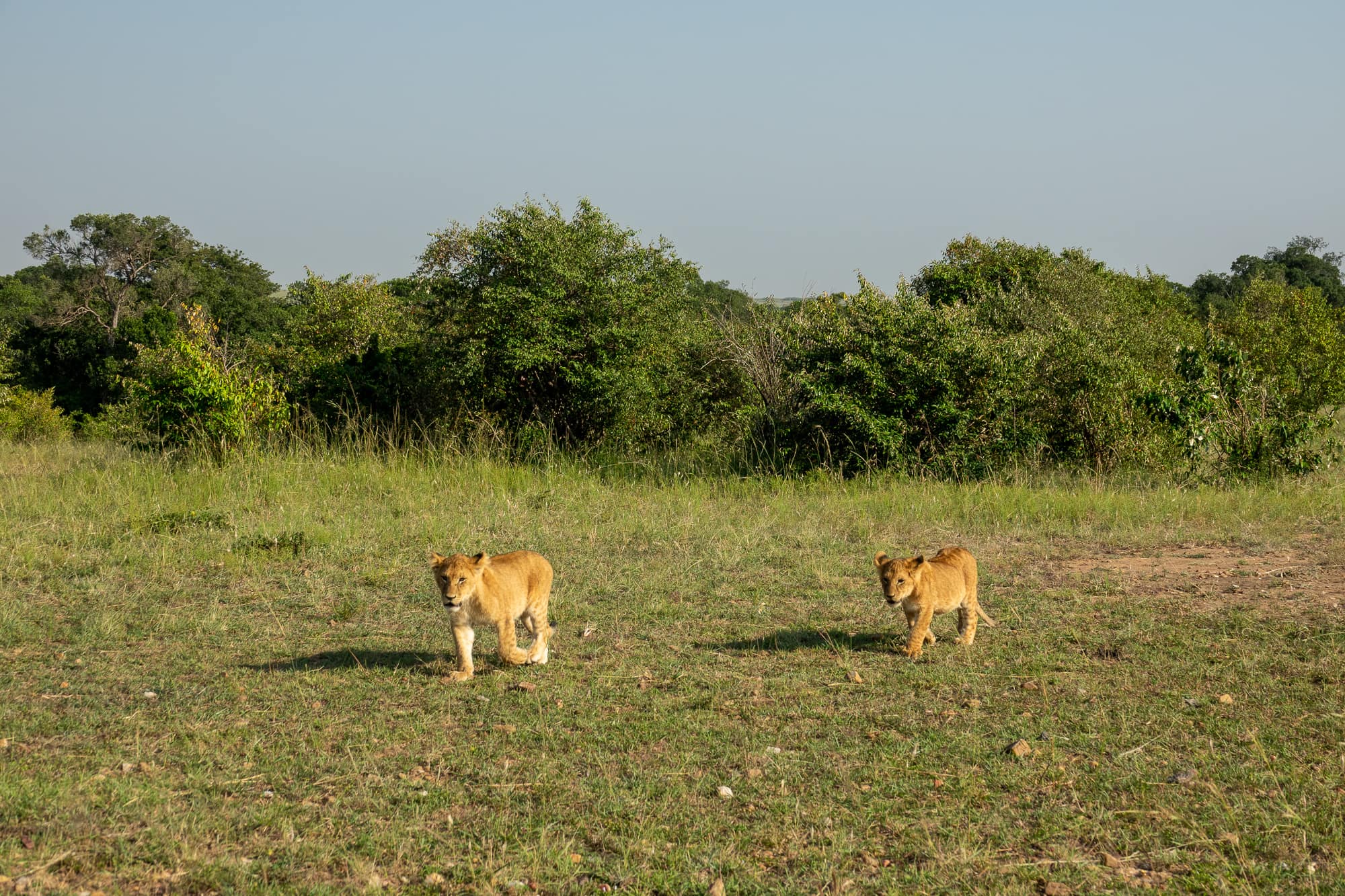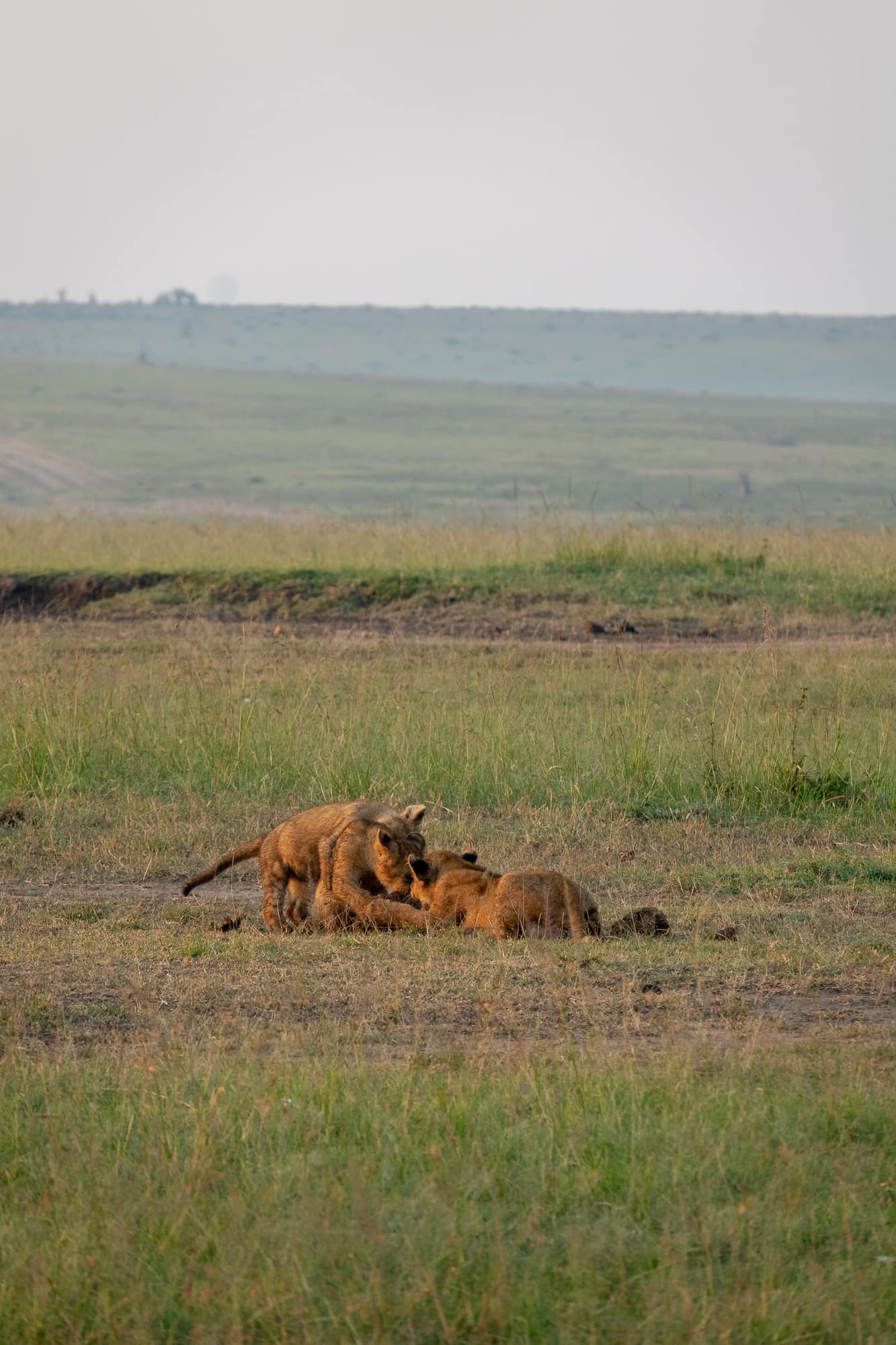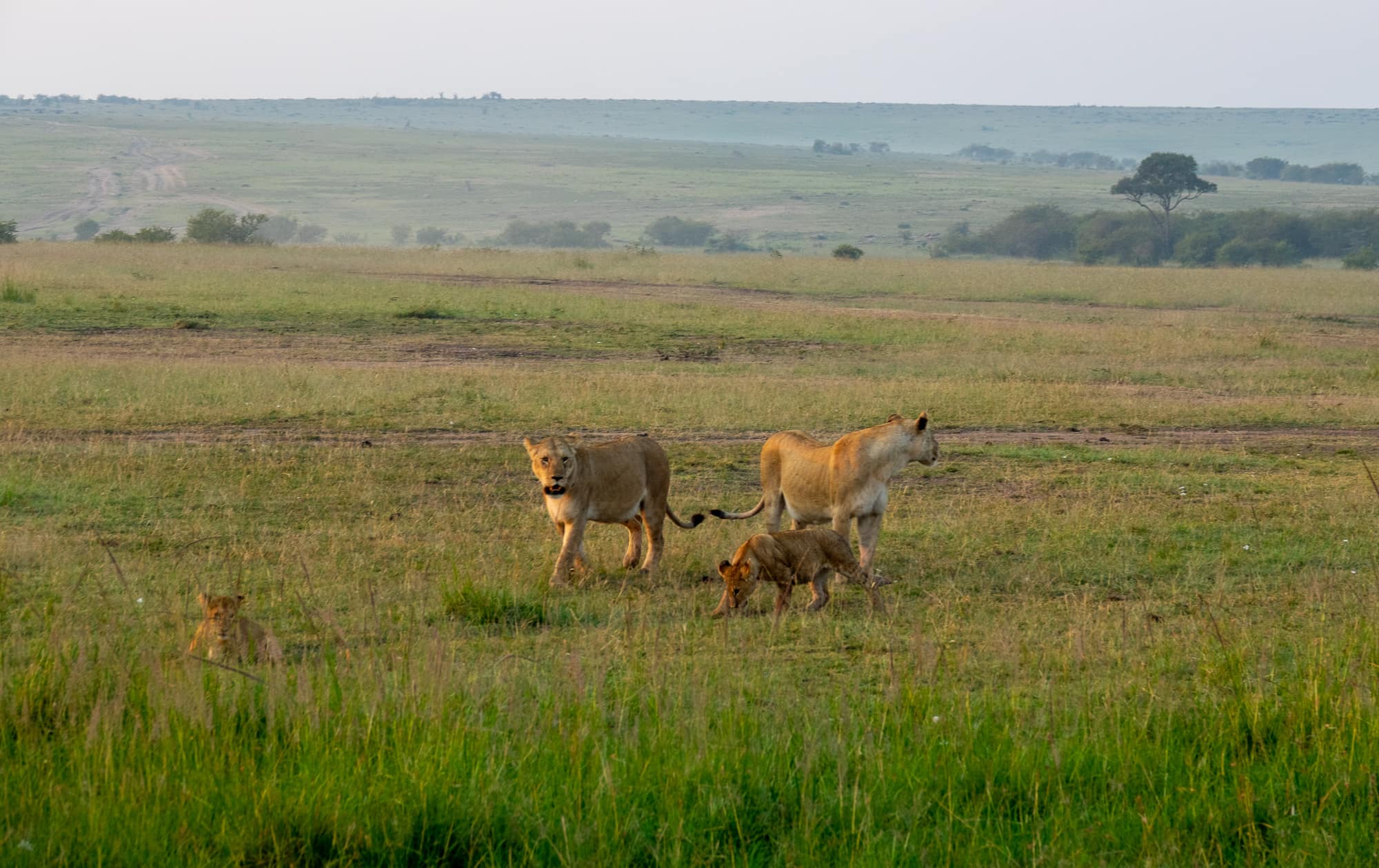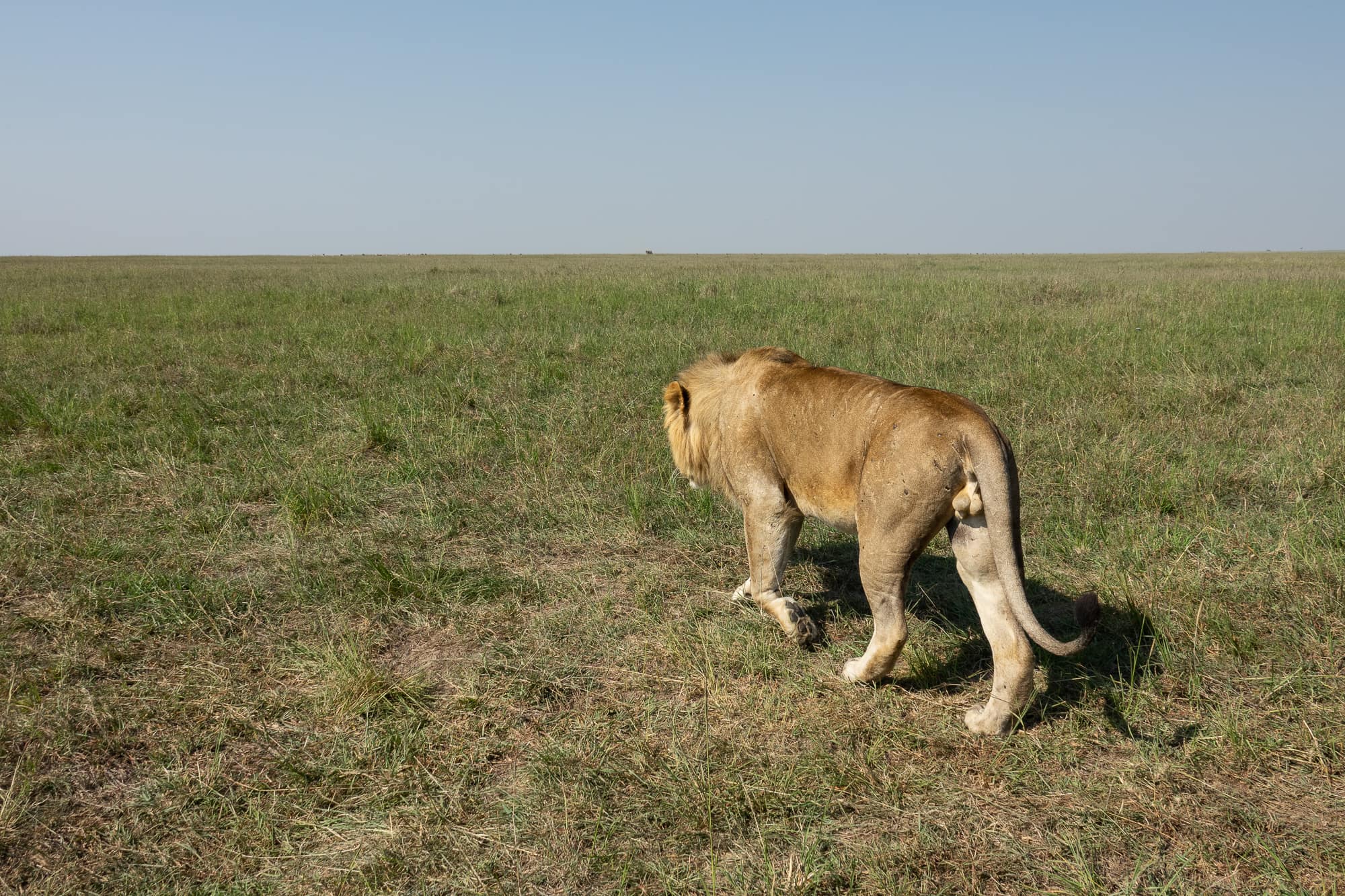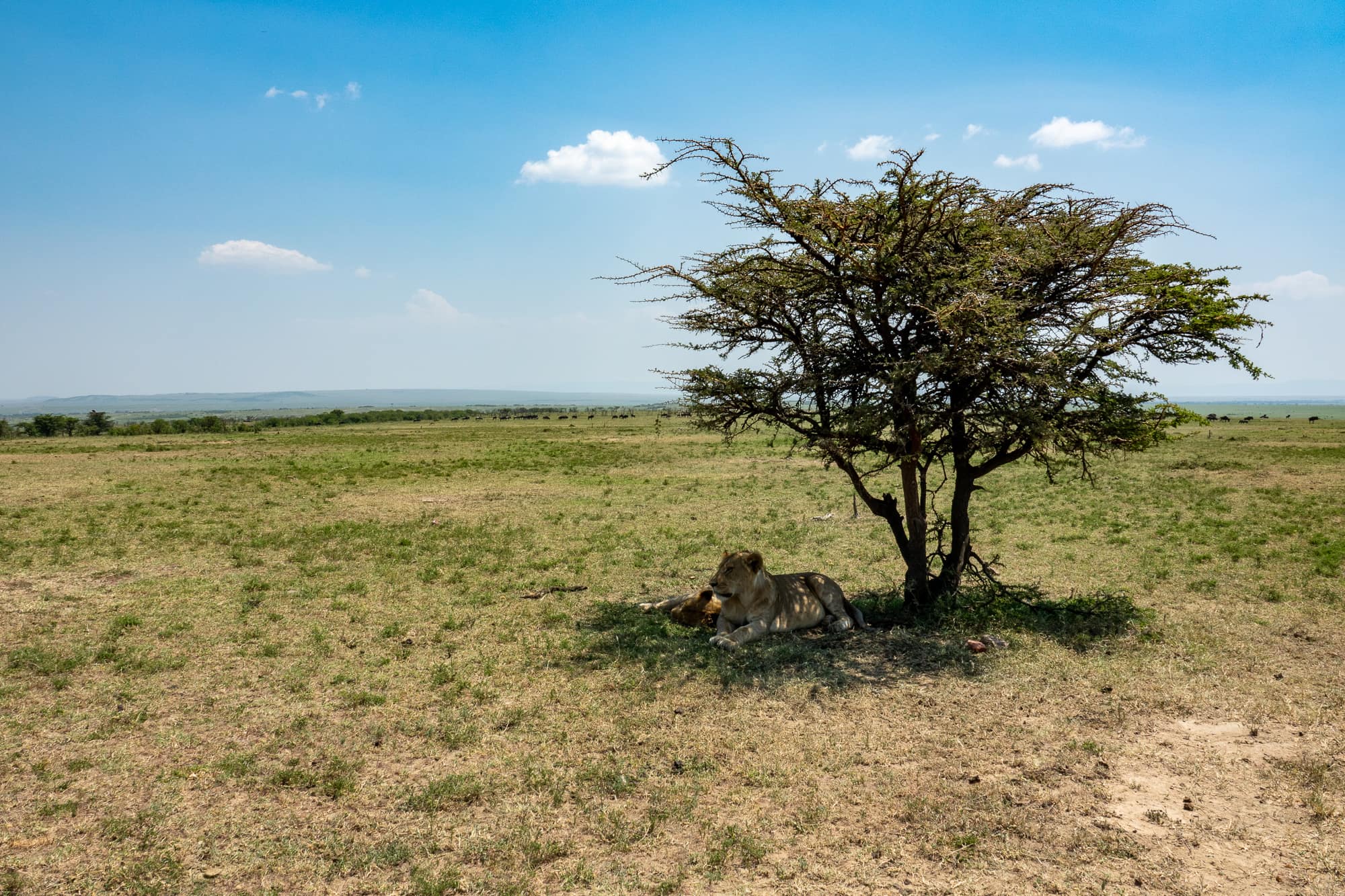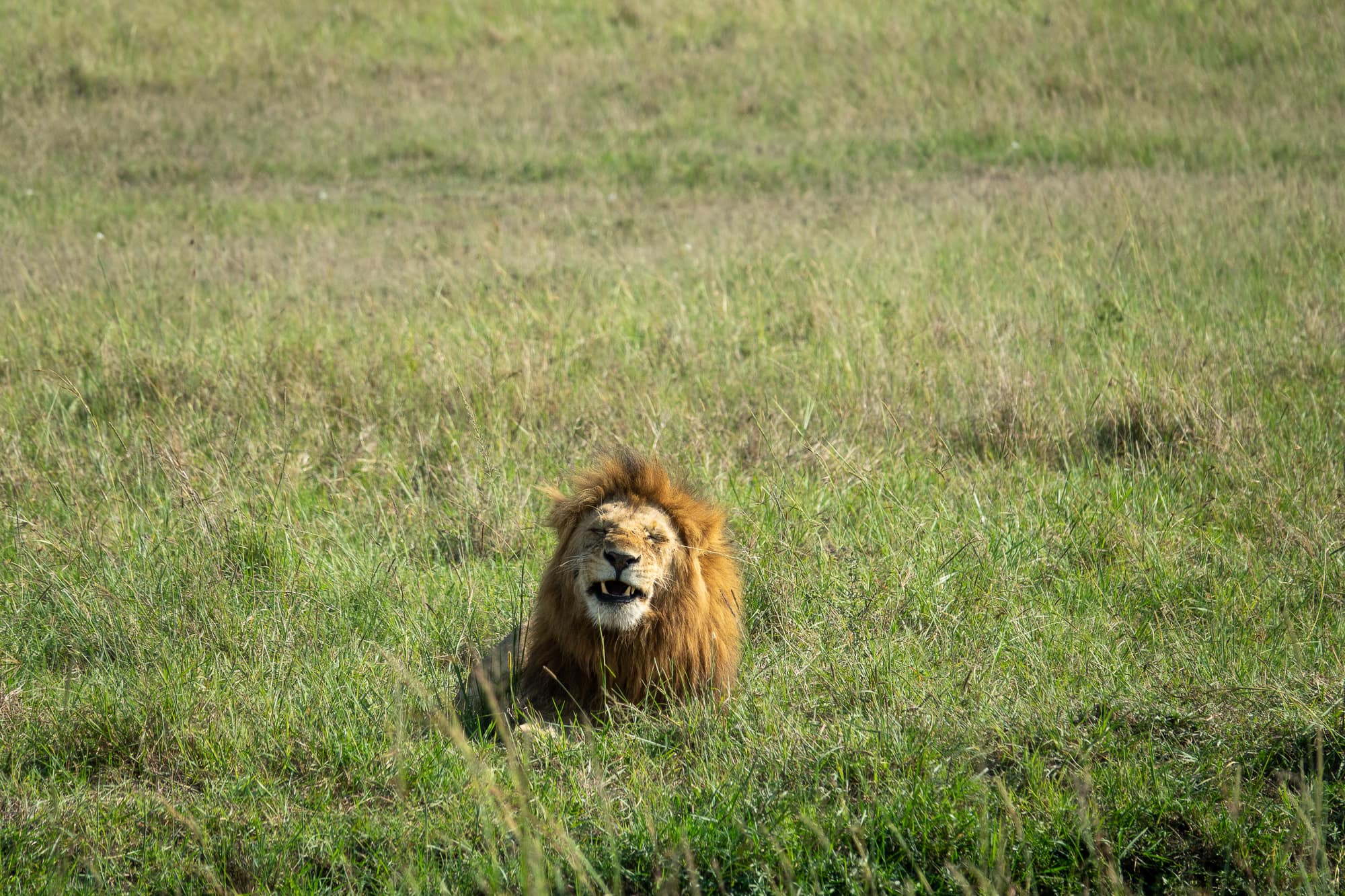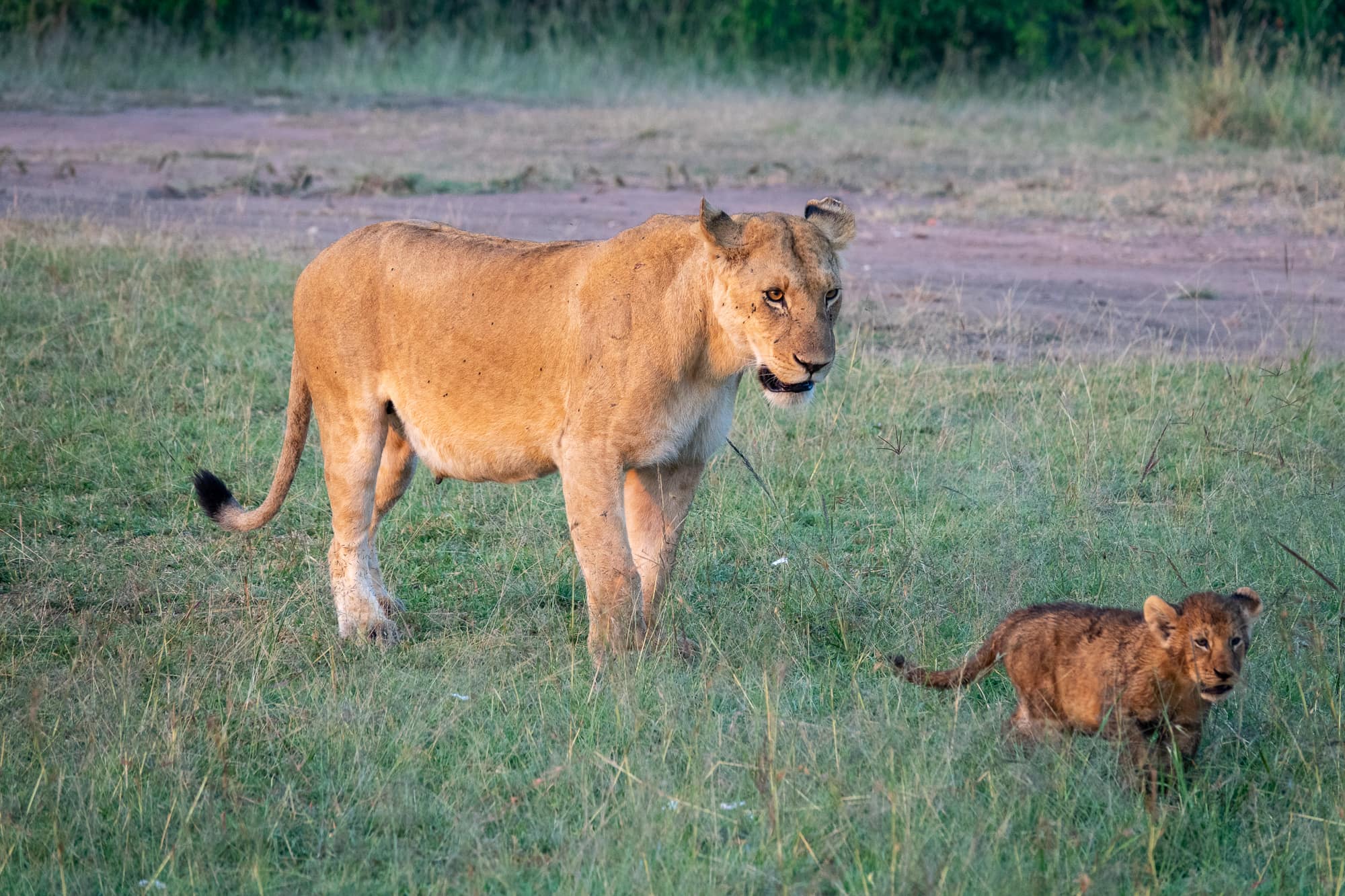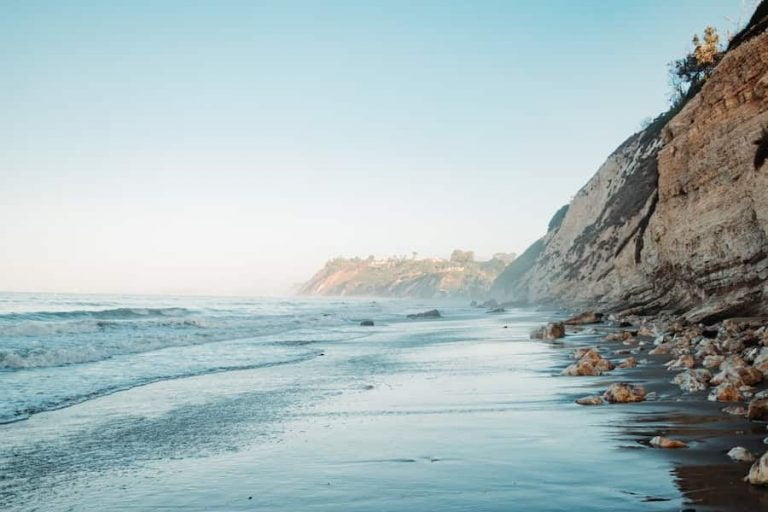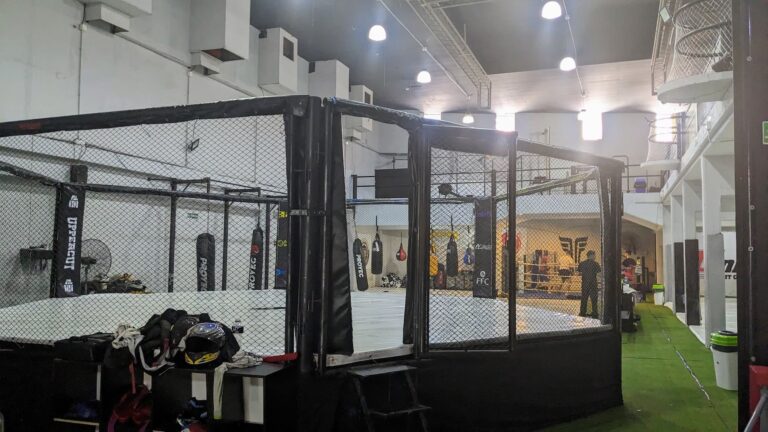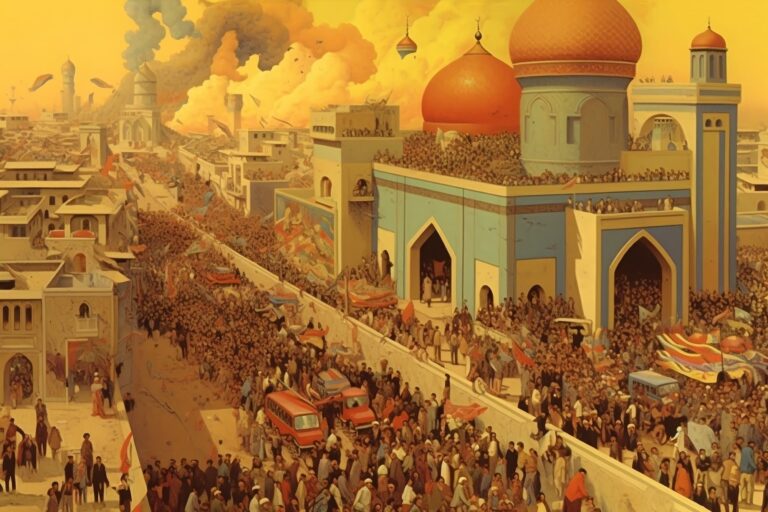Safari in Maasai Mara (Kenya) during the Wildebeest Migration
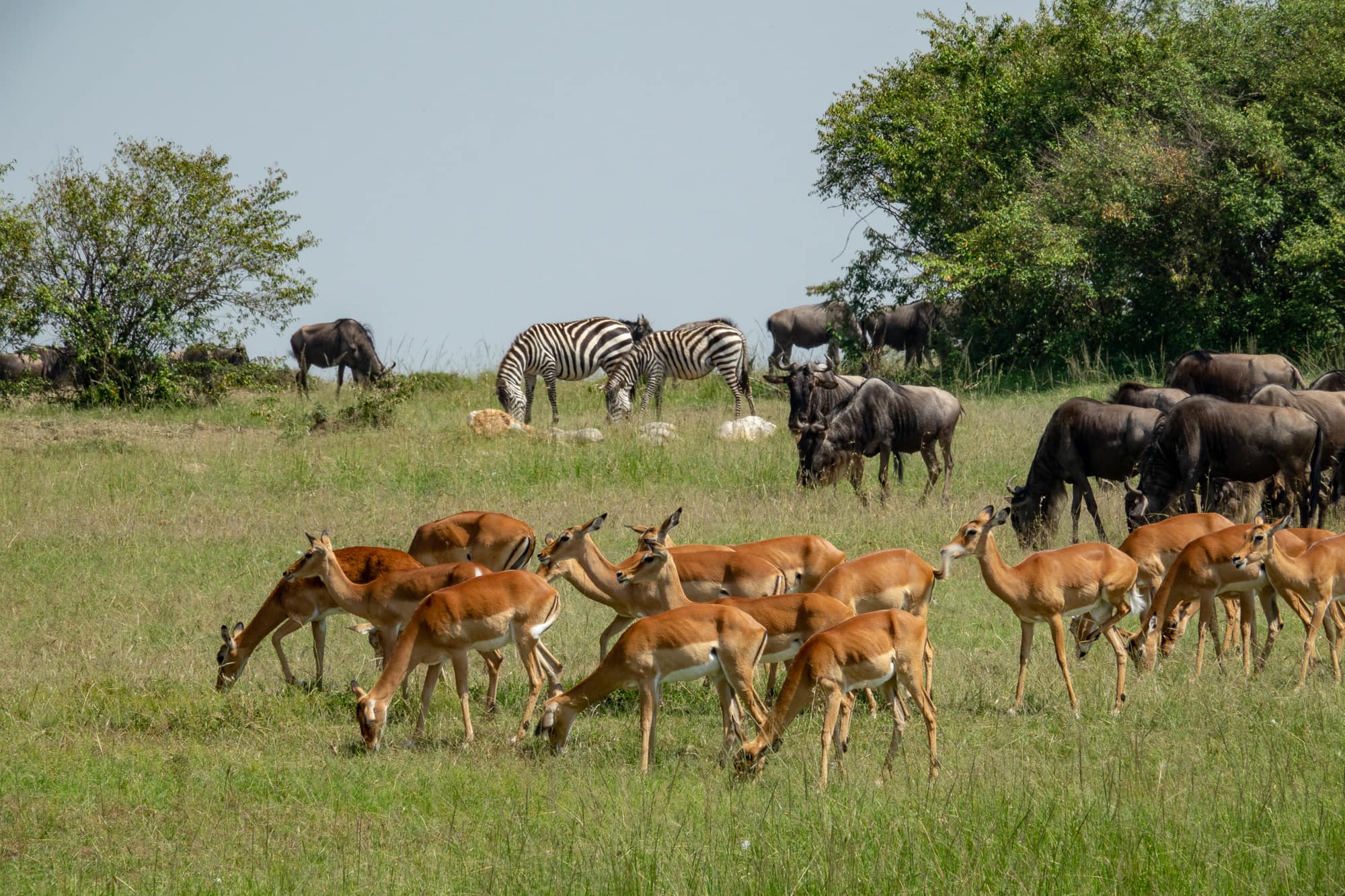
Safari is more than just a vacation. It’s more than photos of animals. Safari is oxygen.
Especially when it’s during the annual Wildebeest Migration, one of the largest over-land migrations in the world, with millions of animals roaming many hundreds of kilometres in search of food and water.
We’re not big on “touristy” things. We visited East Africa to learn Swahili (which we did) and about East African culture. We especially avoid flashy things like safari, with its sky-high prices for accommodation, park entry, and guides (more on how we went on safari for only $500/head later).
But we were captivated, more than anything else, by the complex feeling of being on safari. It was a feeling of inspiration from seeing diverse masses of thousands of animals, roaming free as if in a painting. It was a feeling of worry, seeing the animals blissfully unafraid of the presence of their greatest existential threat: humans. And a feeling of sadness, know the wildlife was of the degree to which their numbers are precipitously plummeting.
Below are a handful of the animals we saw on safari, and the feelings they engendered.
Note: we included the animals’ Swahili names. For more, see our master list of Swahili animal names.
Contents
The Feeling of Being on Safari during the Wilderness Migration
The most unexpected thing about safari, for me, was the feeling of elation and infinite sadness that it brought.
Before going, I thought of safari as a tourist-oriented, expensive endeavour in which we got to see some animals. Safari is undoubtedly a privilege. Even if doing it on a budget, as we did, it will cost around $500/day, excluding flights. And for all-inclusive packages, covering transport and multiple parks, it will cost thousands. It certainly costs much more to go on safari than to rent a car and drive around Africa, and the conservation fees for the parks are incredibly high.
Safari is also usually a “luxury” endeavour. Typically, accommodation (which starts at around $100/night) and drivers provide all your food. You have a driver and a vehicle at all times. Even if you forego accommodation by camping, self-cater, and opt to go on a walking safari rather than in a car, you will pay over $100 per day per person, and miss seeing most of the wildlife by walking (the parks are massive, and the animals very spread out).
But despite the costs and the luxury, Safari should not be cast aside as an experience for wealthy tourists. Safari is a privilege for those lucky enough to live in this generation, while the animals are still alive and have space to roam, and while tourism from the world’s rapidly growing middle class has not all but crushed the infrastructure that supports seeing them in their natural habitat, or priced the opportunity out of reach of most people.
Seeing animals roaming in the wild during the wilderness migration in huge numbers regularly made me swear under my breath at its unexpected majesty. It felt like watching an over-the-top painting, or a scene from a movie with unrealistic computer-generated graphics. The ponderous pace of giraffes as they gracefully loped through an open plain was a scene straight out of Jurassic Park. The naturally expressiveness in zebras’ eyes as they watched us gape in awe made us unconsciously wave and mouth “hello”. The driver asked us regularly to say when we wanted to stop, but this wasn’t much help, because we wanted to stop everywhere.
Even though you can’t leave your vehicle while on safari (by regulation — rangers will fine and threaten the license of your driver), we were so surreally close to the wildlife. That they’re still unafraid of people and cars, because of the controlled way in which visitors enter parks, is both magical and saddening. Because we, humans, are the biggest threat to the world’s wildlife.
We regularly heard of diminishing numbers of much of the wildlife. Even though some populations are stable, this was only because of the decrease of illegal poachers. When you stare an elephant in the eyes, you can’t help but hate anyone who could kill one just to sell its tusks. Thankfully, demand for ivory is decreasing worldwide, and many illegal poachers have been put away — but it still exists. Easy solution: don’t use ivory. Destroy the demand. Better, don’t use any unsustainable animal products.
I can’t go on, it’s too sad. But I feel lucky to have experienced safari once, and animal conservation has become yet another thing of primary importance to me. If you have the means, make safari a priority sooner in your lifetime than later, and make it a trip that will support safari for generations to come.
The Wildebeest Migration
We were lucky to visit the Maasai Mara during the Wildebeest Migration of 2019.
It’s hard to explain what it feels like to be surrounded by millions of animals. So just look at this video:
The wildebeest migration is the largest overland migration in the world. The animals travel 800 km (half a mile) in search of food and water. They stay for nine months in the Serengeti in Tanzania, then stamp their passports to cross into the contiguous Kenyan national park of the Maasai Mara, where they stay for three months.
This year (in 2019), we heard estimates that there were 1.5 million wildebeest and half a million zebra in the whole contiguous park, although numbers in the migration have been dropping (see below as to why).
Every year, half a million more wildebeest are born in the Serengeti. During the migration, around 250,000 wildebeest and 30,000 zebra are killed by predators who have been waiting for a good feed to arrive.
A lot of animals are killed by crocodiles waiting in the Mara River for them to cross. The herds usually win in terms of numbers by crossing in hordes, but many are lost to crocodiles. If you can see a river crossing, it’s pretty spectacular!
It’s kind of cruel, animals having to move to eat, with a significant chance of being eaten themselves by lions in the “meaningless line of indifference”, as Simba’s friends put it in The Lion King.
Unfortunately, the Serengeti-Mara wildebeest migration is dying. Numbers have dropped continuously over the last thirty years. The causes are thought to be poorly planned agricultural expansion, fences, settlements, urban centres, roads and other infrastructure, poaching, competition with livestock for resources, and government policy in Kenya encouraging private over communal land tenure.
Wildebeest need to migrate to survive, and the ecological balance of the regions where migration happens also depends on migration continuing.
You can help keep the Wildebeest Migration alive by visiting as a tourist or contributing to conservation funds. Both provide incentives for government and land owners to do what they can to conserve it. So visit while you can!
Some more photos of the sheer volume of animals are below.
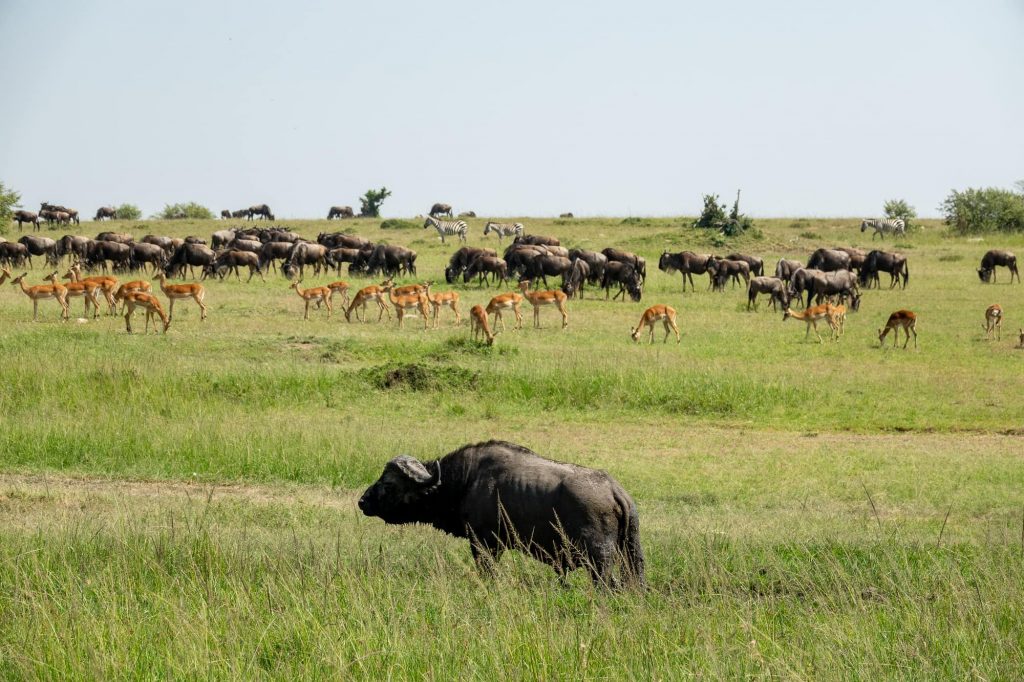
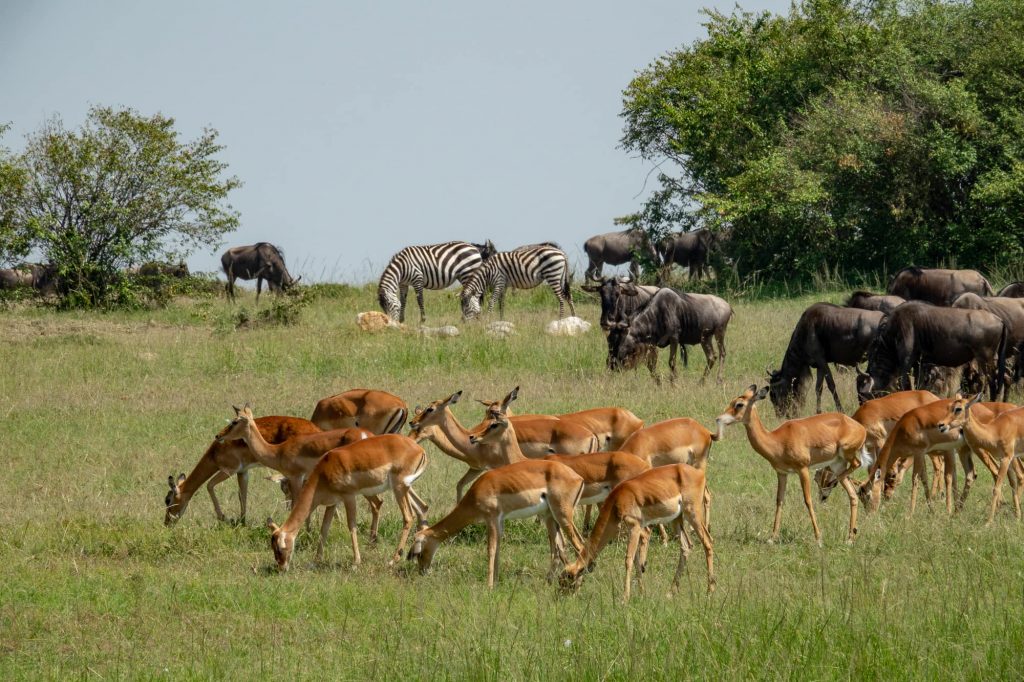
Wildebeest Migration in the Maasai Mara, Kenya
Wildebeest/Gnu (Nyumbu)
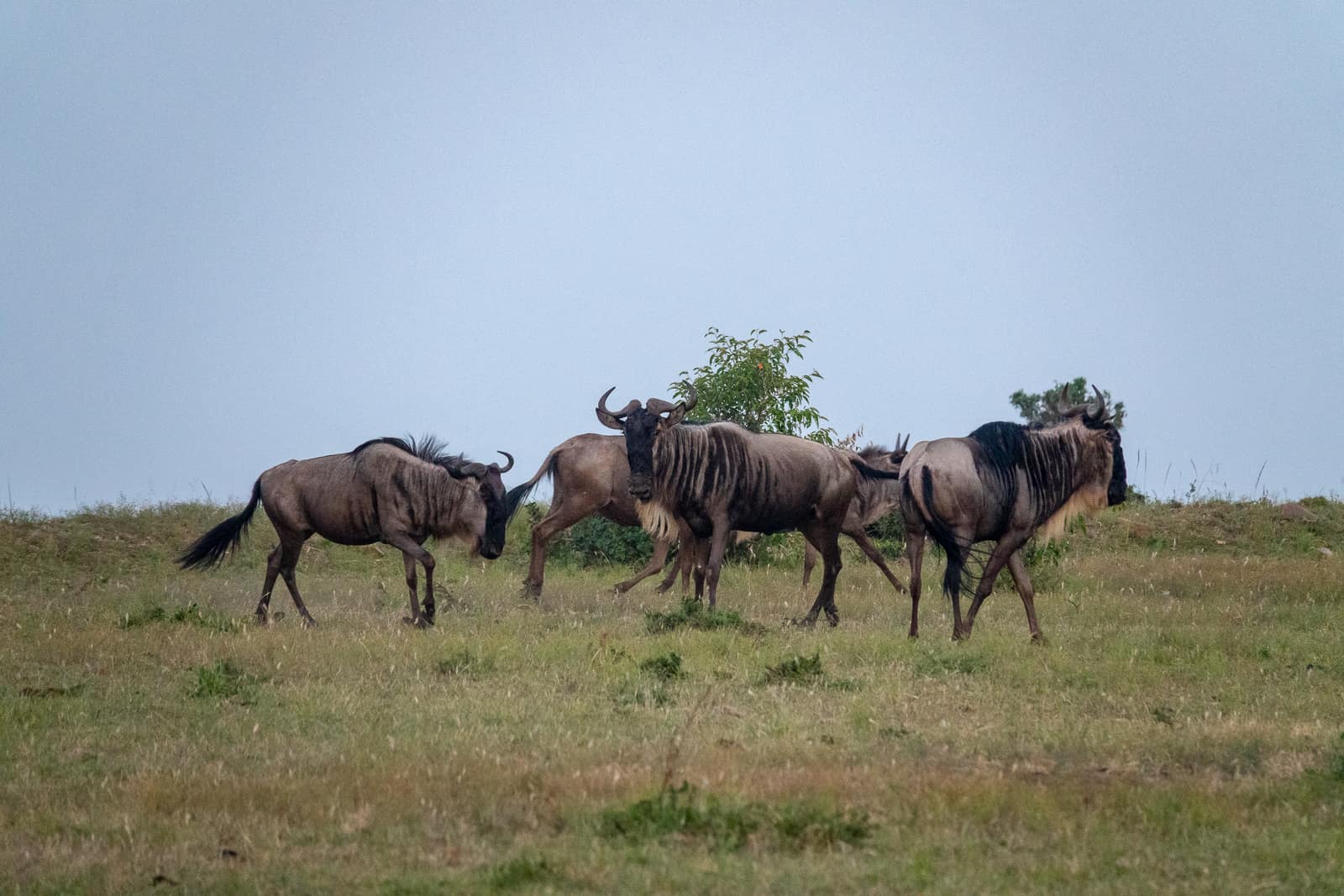
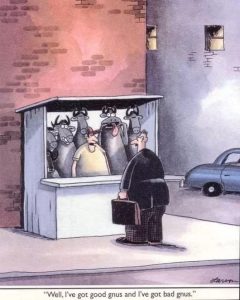
Wildebeest is the Dutch/Afrikaans word for “gnu”, which is pronounced with a silent ‘g’, as this classic Gary Larson cartoon demonstrates.
Wildebeest don’t get the attention they deserve. There are so many of them (millions), and they’re not at all at risk of going extinct. People don’t eat them (apparently they don’t taste great), and their populations are stable. Even the International Union on the Conservation of Nature (IUCN) lists them as “least concern” status. Harsh, IUCN!
But they’re still cool. We loved how they’re always with zebra, and wondered why. Is it just because they’re cute together? Turns out there’s more to it.
Firstly, zebra and wildebeest don’t compete — they eat different parts of the same grass! The zebra’s mouths are good at grabbing the top bit of long grass, and wildebeest’s teeth are better at chomping short grass.
Secondly, zebra are better long-range navigators. They have better memories, and can remember where the danger lay in the previous year’s migration. So they lead the way.
Thirdly, wildebeest are better at finding nearby water. They have to drink much more often, so they’re geared to find water.
And finally, zebra are better at spotting imminent danger, like crocodiles and hippos (see below). While wildebeest tend to just stampede their way through river crossings, zebra will first alert the herd to danger.
Also, they do look cute together.
A key Maasai phrase we learned was Ingatí kumuk, which means “many wildebeest”. (In Swahili it’s nyumbu mengi).

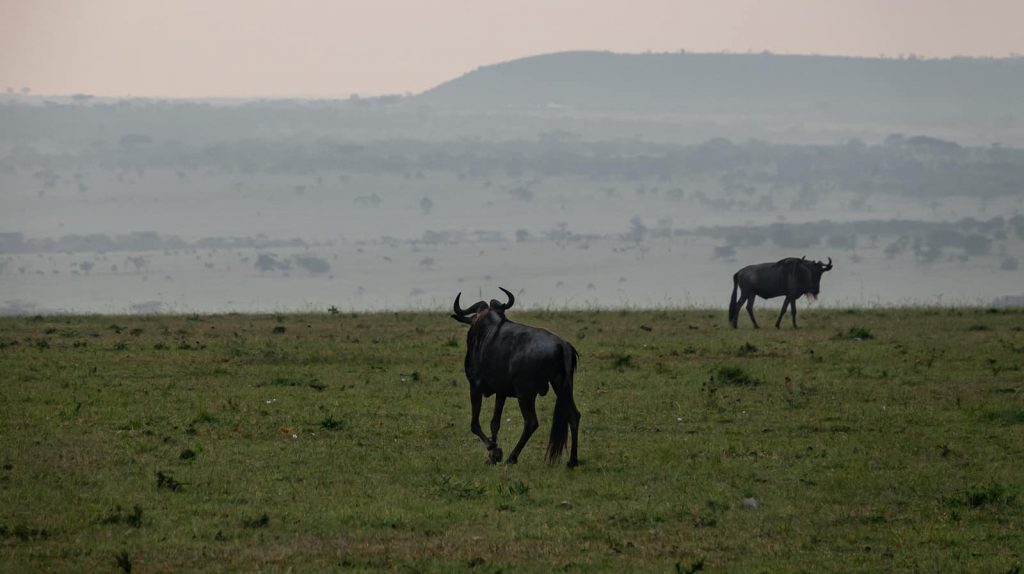
Elephants (Ndovu/Tembo)

Elephants, I decided, are my spirit animal. They move slowly, deliberately, and always in the company of their loved ones. When elephants are going somewhere, everyone else gets the hell out of way. Elephants are also most dangerous when they have a little one to protect.
Happily, elephant populations in Kenya are increasing! I was shocked to learn this too. The main cause of the increase is a massive (80%) reduction in poaching in the decade of the 2010s.
Poacher numbers are decreasing, which is the one thing going extinct that I can celebrate. Elephant poachers are the worst. We’ve met many soldiers patrolling for poachers, and they rarely find any. Hooray!
Aside from donning a ninja outfit and intercepting poaching gangs, or contributing to wildlife conservation funds, there’s something simple you can do to prevent poaching: don’t buy ivory. Don’t buy ethical ivory, repurposed ivory, or anything ivory. The more it’s taboo, the lower demand will be, and that’ll hurt the industry.
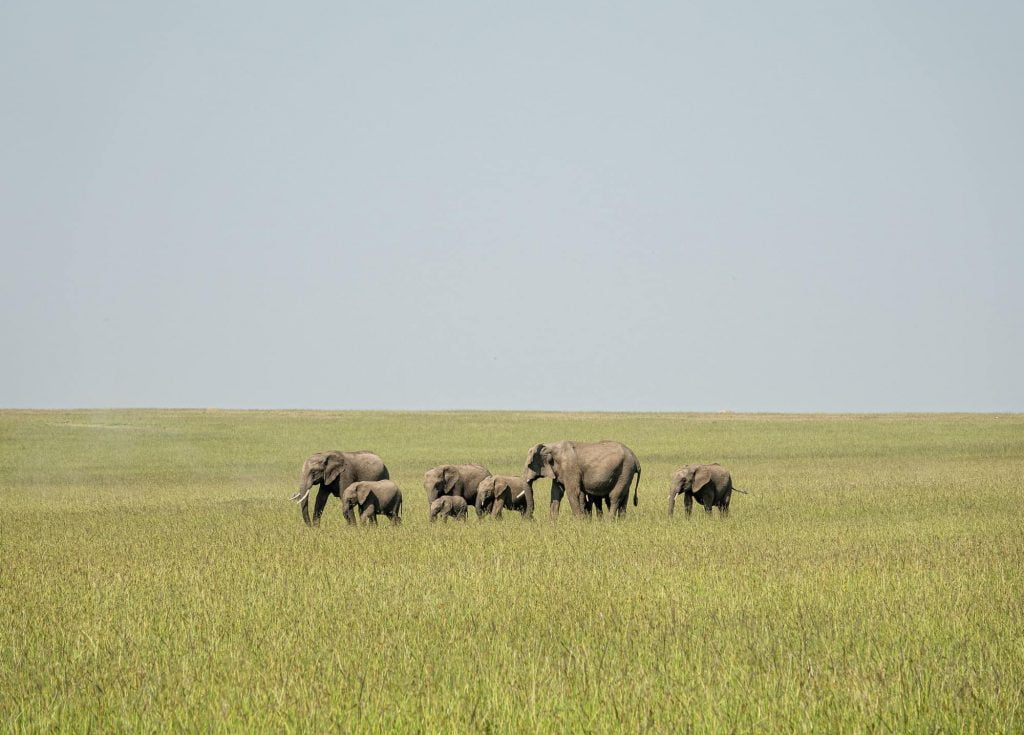

Zebra (Punda Milia)

Zebra are animals that most look like they were invented by graphic designers. Surprisingly, we learned that instead of being white-skinned with black stripes, zebra are actually black-skinned underneath the white stripes!
Zebra are in the same family as horses and donkeys, as you’d expect. In Swahili they’re called punda milia, which means “striped donkey”. This is actually a common way of naming zebra in many languages (Chinese and Arabic for example). The Maasai word for zebra is stand-alone though – oloitiko, whereas the Maasai word for donkey is osigiria.
There are many kinds of Zebra, with distinctive patterns. In Eastern Africa we most often see a “plains zebra”, so named because they live on the plains, rather than in apartments. But we saw some sub-types of plains zebra, too. Apart from regular zebra, we also saw, grey zebra, which it turned out were regular zebra from far away, and brown zebra, which it turned out were donkeys.
And yes, donkeys and zebra can interbreed, though the offspring are often not viable (huge difference in chromosomes)and if they are, they’re infertile, and honestly weird looking, with stripes in random places. Perhaps I’m not open-minded enough.
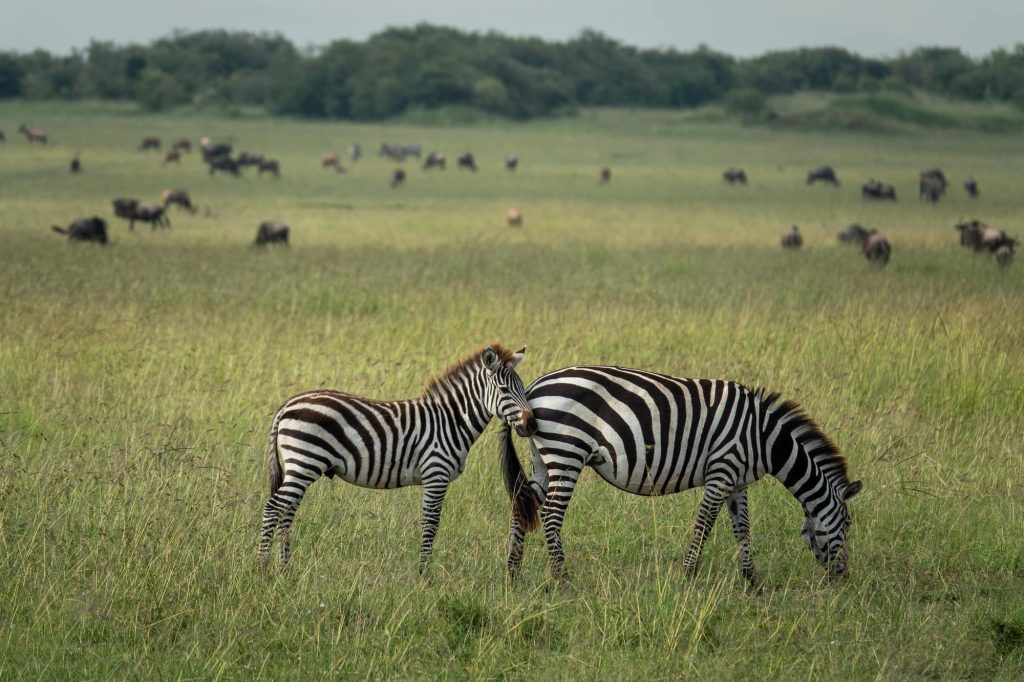
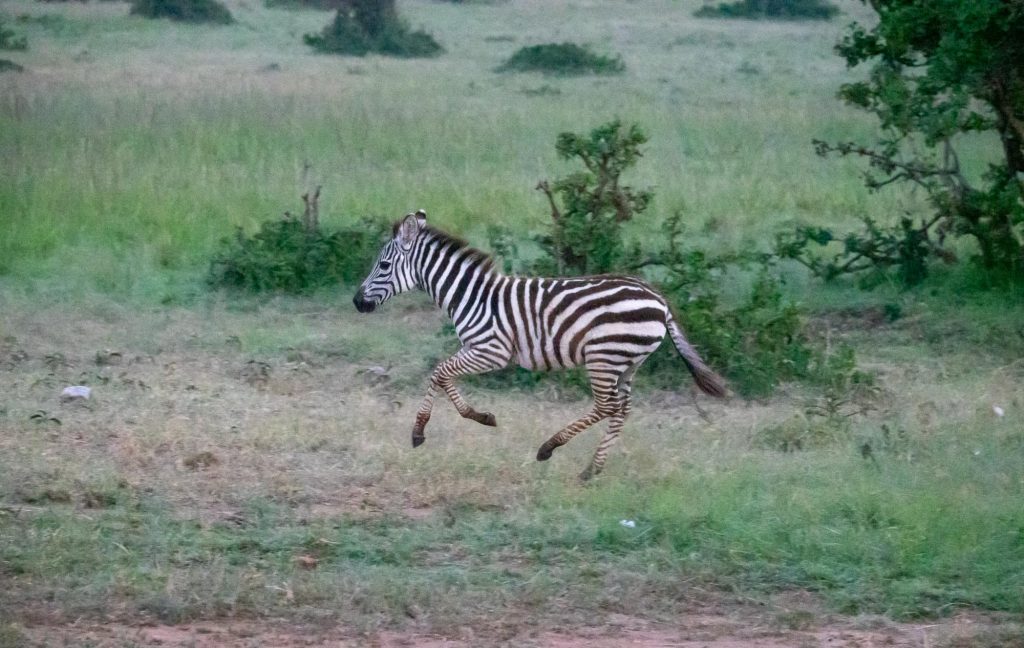
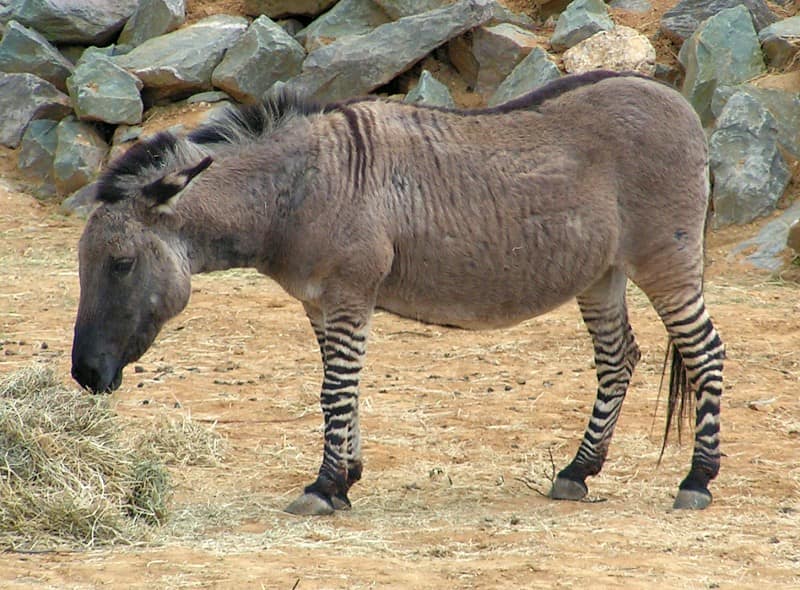
Giraffe (Twiga)
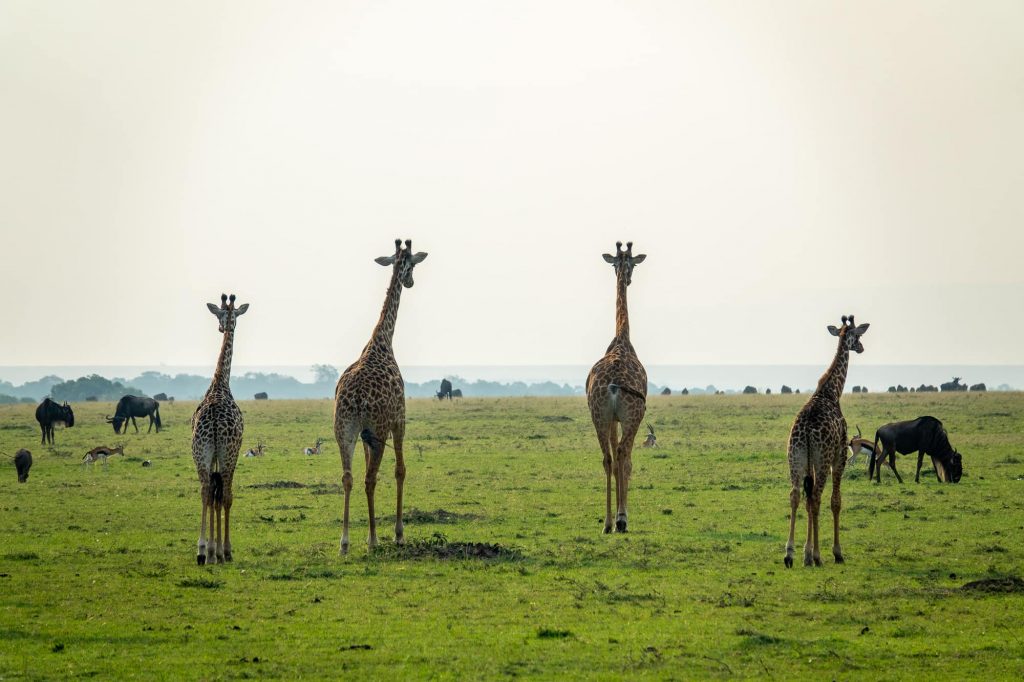
Giraffe, like elephants, are large, graceful animals. To watch them parade slowly through the grasslands of the Maasai Mara was therapeutic. Their expressive faces just beg to be anthropomorphised. But really, they’re just watching to see if we’re a threat as they chew cud.
They can also move quickly. You’ll often see them galloping gracefully, moving over 50 km/h (35 mph).
We wondered why we only saw giraffes on the move. It’s because they spend basically their whole lives standing up! They sleep standing up, give birth standing up, eat standing up, and work standing up at their standing desk, which is the only kind of desk they have.
They’re also really productive coders, by the way, because they’ve managed to hack down sleep to less than 30 minutes per day.
Nonetheless, giraffe numbers are on the decline. Not as dramatic as some animals, but still down 30% over the last 30 years, with numbers down to around 100,000 across Africa. The International Union for the Conservation of Nature says they’re undergoing a “silent extinction“.

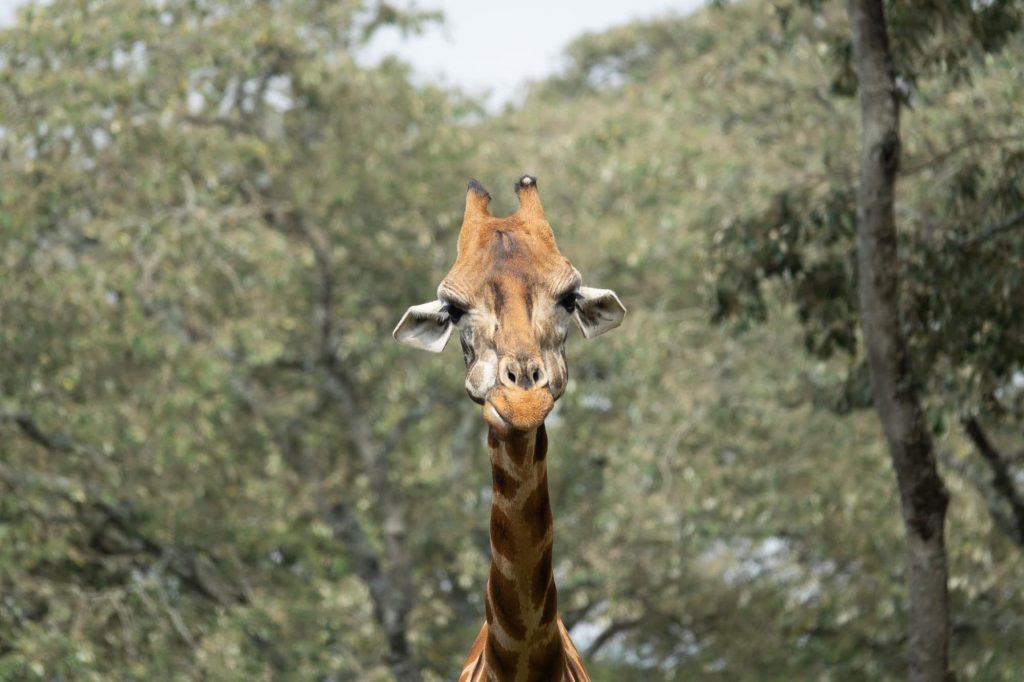
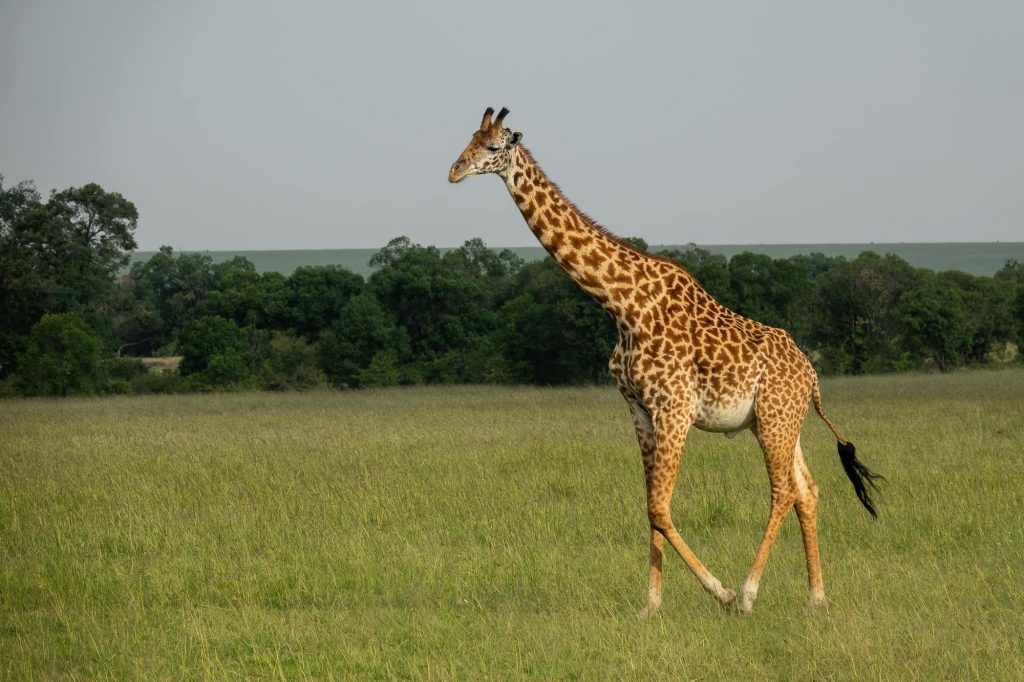
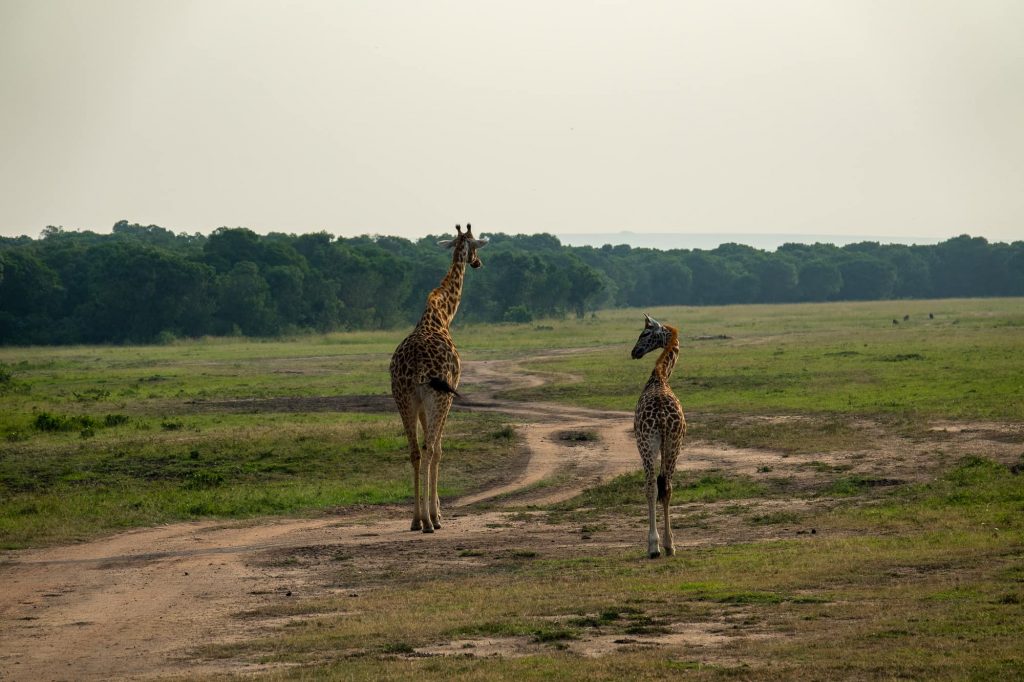
Leopard (Chui)
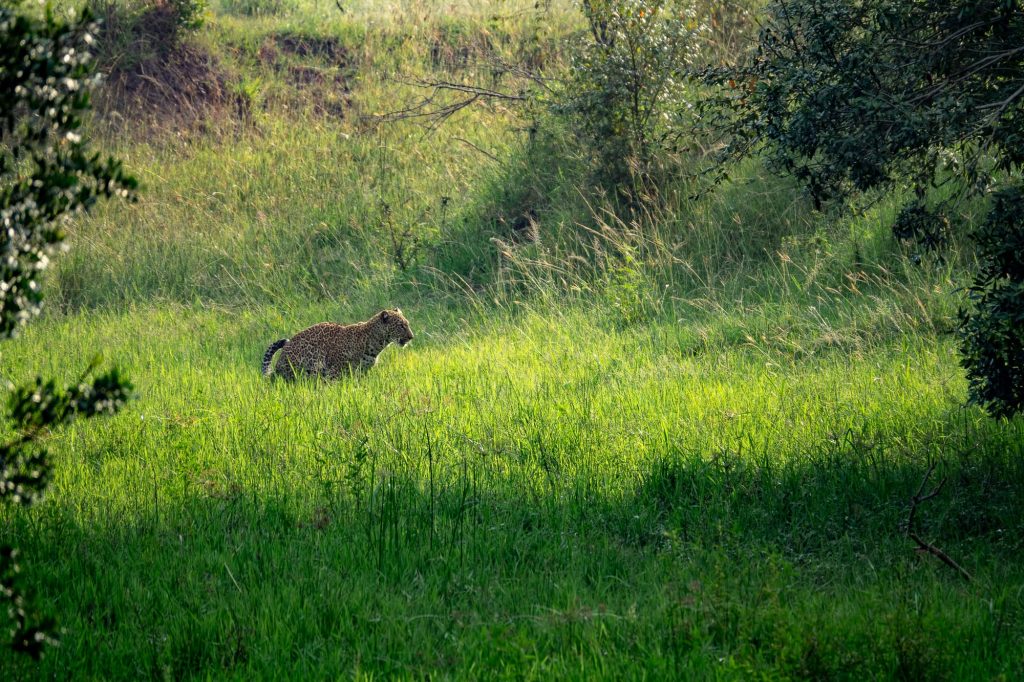
It’s always exciting to see a leopard. They’re highly solitary and like to mark their territory by peeing and pooping in an area, warning every other leopard off except leopards of the opposite sex, who sometimes wander by to mate. “Don’t mind the pee and poop. It’s kind of my thing,” they say to dates, who never mind because at least it’s not their pee and poop some other leopard has to smell. How mortifying!
Leopards spend most of their time on the ground, but they’re also really good climbers. That’s why a lot of photos you might have seen in Nat Geo and the like are of them in trees.
Even though it’s rare to see one, there are heaps of leopards in Africa, with over 700,000. They’re just quite spread out. Nonetheless, they’re at risk, as constant development pushes them out of natural habitats. The IUCN has listed them as “vulnerable“.
Don’t build houses on leopard land.
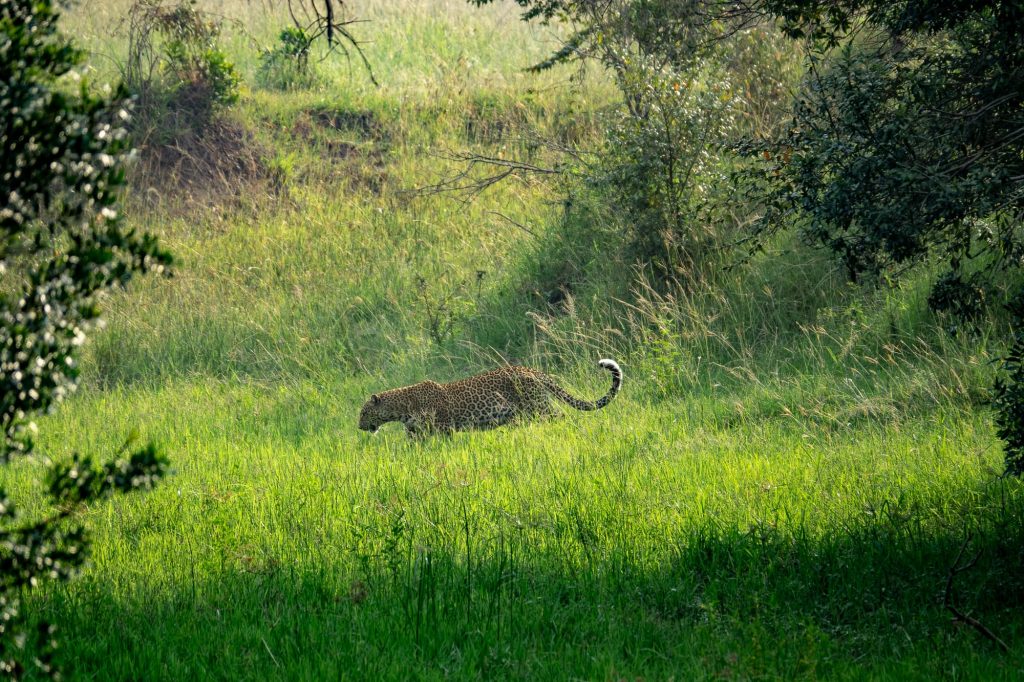

Antelope, from Impala (Swala Pala) to Gazelles and others
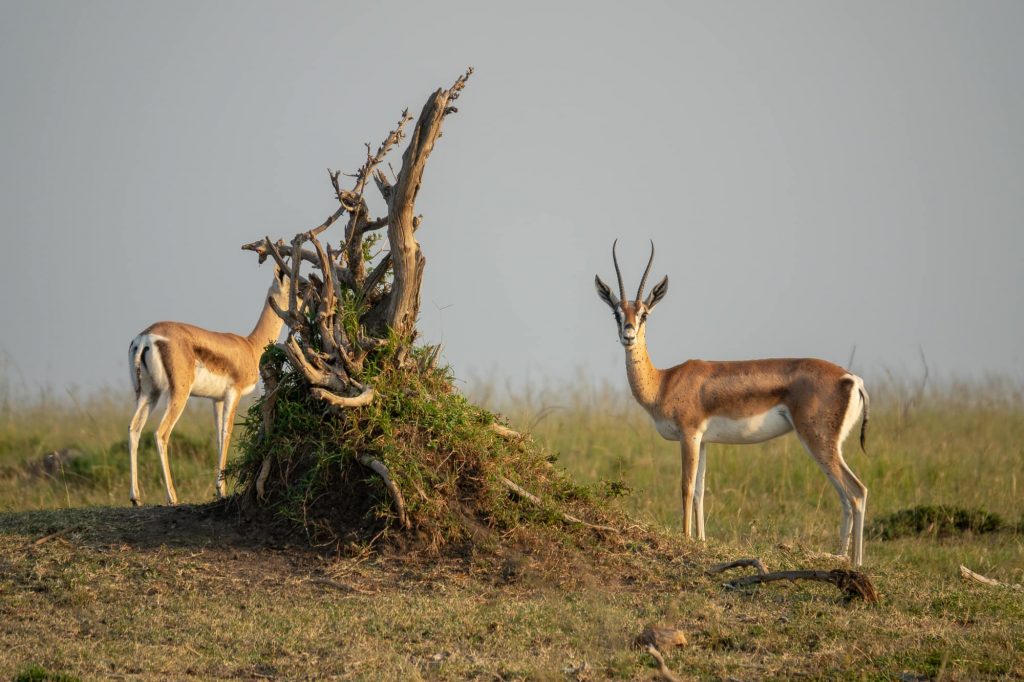
There are many kinds of antelope, and like zebra, they all look like they were made by a graphic designer. Most of what we saw were Thompson Gazelles, but there were others too, like Eland, and tiny Suni.
Gazelle are common prey for lions, and sometimes for people. Apparently, they’re almost as delicious to eat as they are to watch. That’s a hard joke to make… and one more step towards me becoming vegan, I suppose.
Antelope (in their various varieties) are mostly listed least concern by the IUCN.
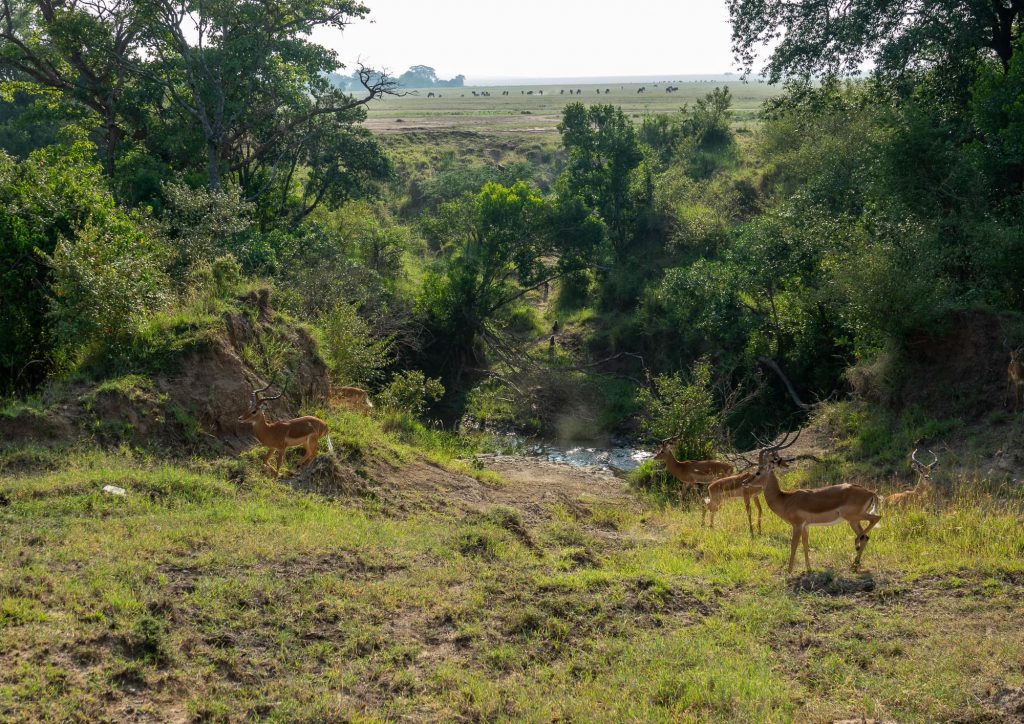


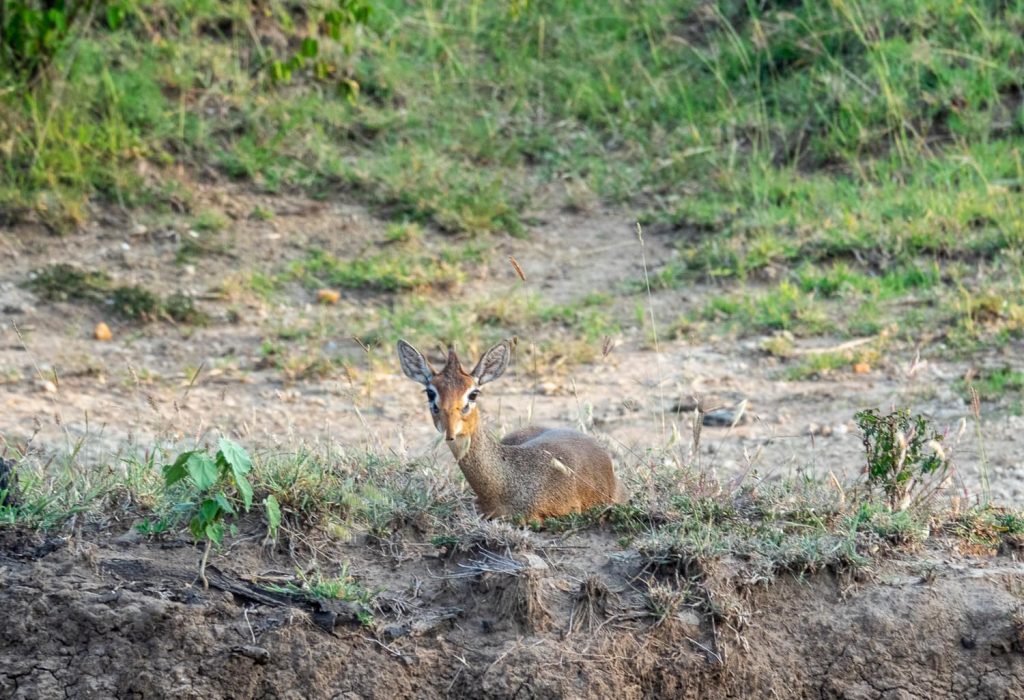
Lions (Simba)
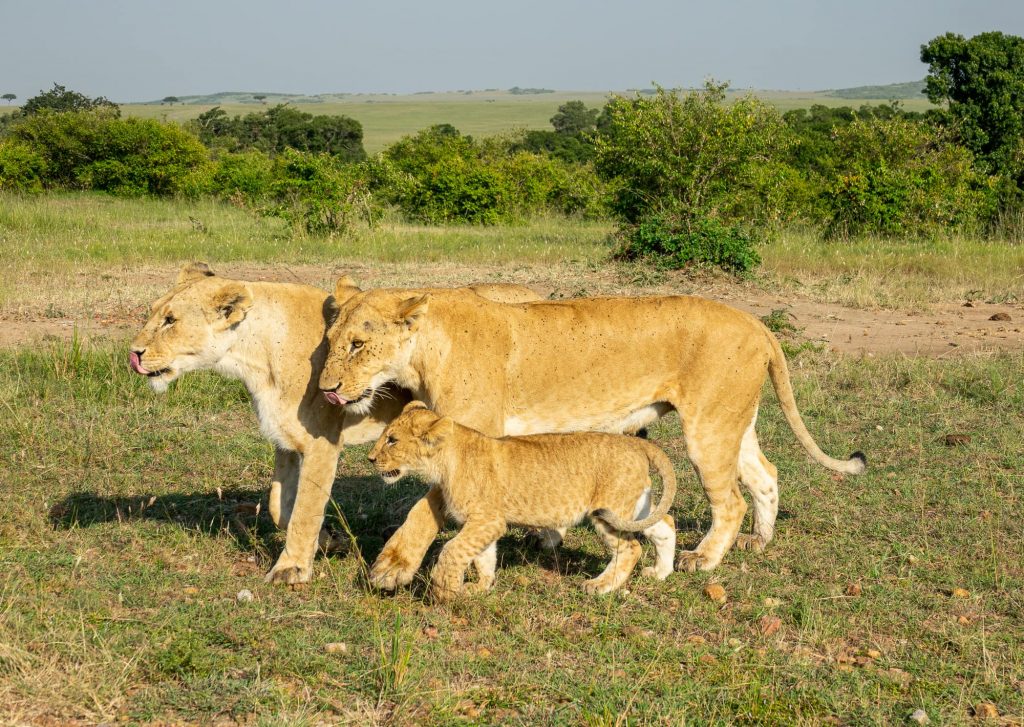
YES, lions are what you came for. If you were scrolling down looking for them, you can stop!
On a typical day in the Maasai Mara it’s normal to see lions at least, and sometimes twice. The rangers call other cars to come to the lion spots quickly, so you’ll almost definitely see them.
Firstly, yes, “simba” is the word for lion in Swahili. So Simba the lion from The Lion King was just “Lion the lion”. (“Mufasa” is not an animal, nor even a traditional name; at best it’s vaguely related “Mustafa”, one of the names of Muhammad.)
Lions are the most sociable of all big cats — most cats are very solitary! Lions live and roam in prides of about 15 individuals — five to 10 females, two or three males, and the rest their cubs. Lions even have a system of teamwork and division of labour. Male lions fight to maintain territory and the right to breed, and females do the hunting, probably because they don’t have all that hair from manes to get in the way.
Like most cats (big and small), lions rest for most of the day, for up to 20 hours.
Lions are often described as being at the top of the food chain. But lions have one major predator that is slowly killing them all: humans.
Lions are in decline, no matter how you slice it. There’s only 10% of the lions there were a hundred years ago. Lions occupy only 8% of the land they once did, and are extinct in 26 African countries. They’ve declined by nearly half in just the last 20 years. There’s just 20,000 left! They’re not “endangered” overall, but they are in some parts (where they’re not extinct) and they’re “vulnerable” overall.
The main things causing lion populations to go down are the same as with many animals, but a combination of all of them: habitat loss from human encroachment on their territory, illegal poaching (and poorly regulated legal trade), disease, and climate change affecting inhabitable regions.
So what can you do? Choose an eco-tourism friendly safari operator that actively educates about lion conservation and contributes to projects that aim to increase populations. Or just adopt a lion via the WWF.
Buffalo (Nyati)
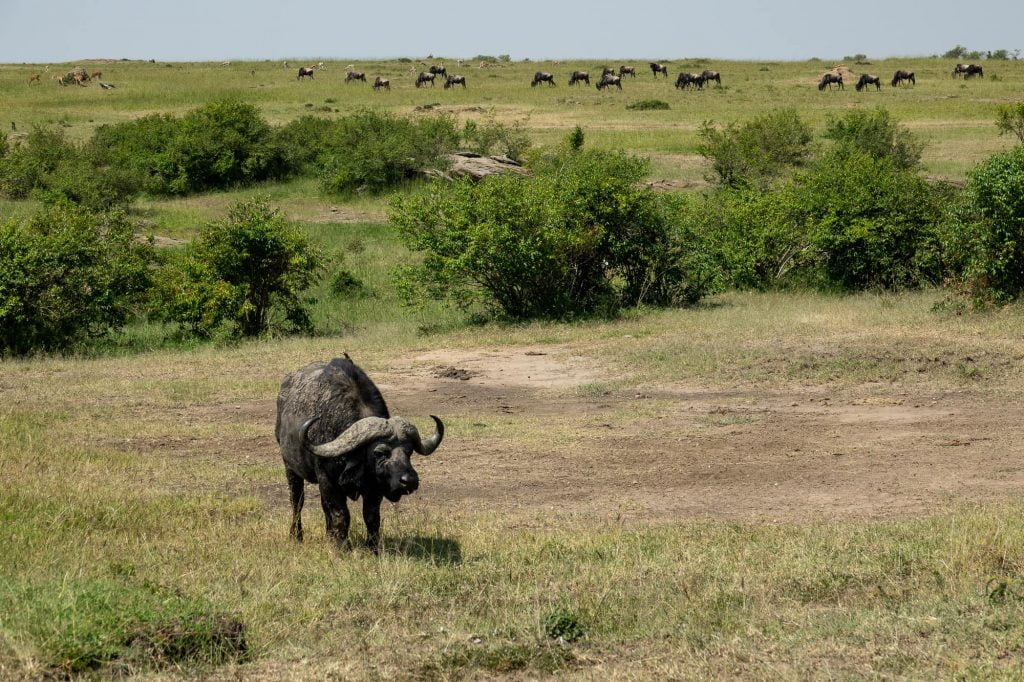
African Buffalo (different to Asian Buffalo) are huge animals, weighing as much as a small car. They’re one of the “Big Five” game animals everyone wants to see, but they’re really put the “big” in “big”.
We only saw buffalo alone, but they can congregate in herds of thousands. Which is scary, because they can be dangerous as hell! They’re really protective, especially in groups, and have been known to charge and gore people.
But usually, they were just bathing in mud, trying to shed heat I suppose. Buffalo are warm-blooded, but they have a tough time regulating heat as they’re so large and thick-skinned, though according to buffalo they’re more “big-boned”.
This is probably part of the reason why they’re not threatened. The IUCN has them as “near threatened“, though, with populations decidedly decreasing (they’re under 400,000 now).
Hippos (Kiboko)
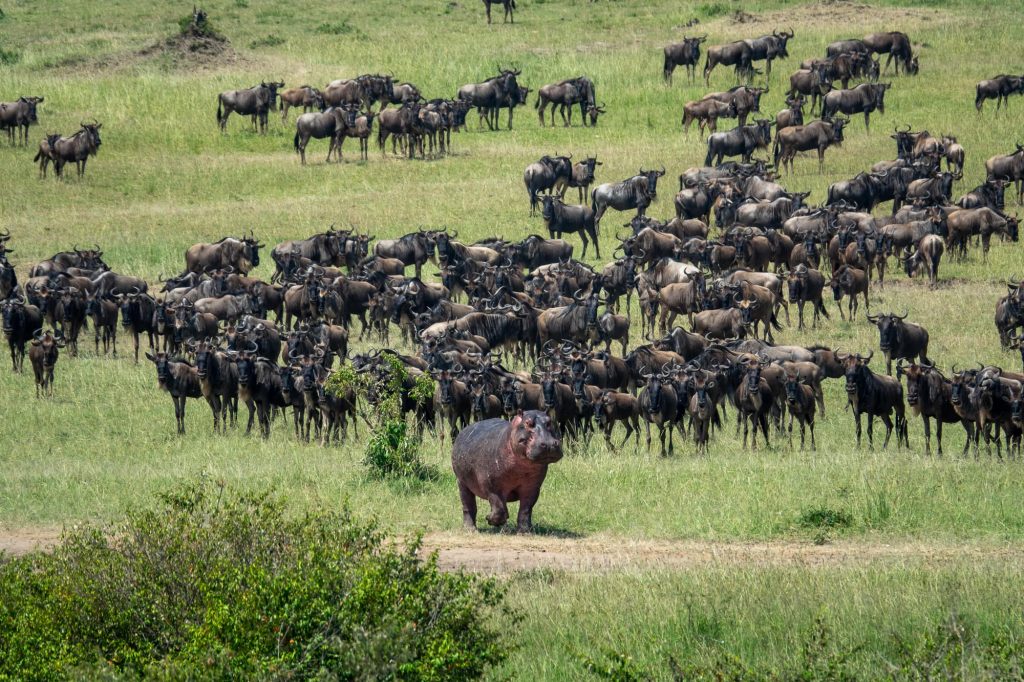
Hippo are massive, second in size only to elephants. They weigh over 3,000 kgs, or about as much as a Tesla Model 3. Unlike Teslas, however, Hippos are fully autonomous. Unfortunately, this full autonomous mode is intentionally deadly!
Because it turns out hippos are extremely badass and quite dangerous. Enough to stop a bunch of wildebeest from migrating across a river. The one pictured actually caused a brief stampede. One hippo against hundreds of wildebeest! Hippos have very powerful jaws, with a bite three times as powerful as the Great White Shark, and with some teeth two feet (more than half a metre) long!
Hippos are herbivores, but they do attack people, other animals, and Land Rovers, but only recent models outfitted with wealthier, air-conditioned tourists.
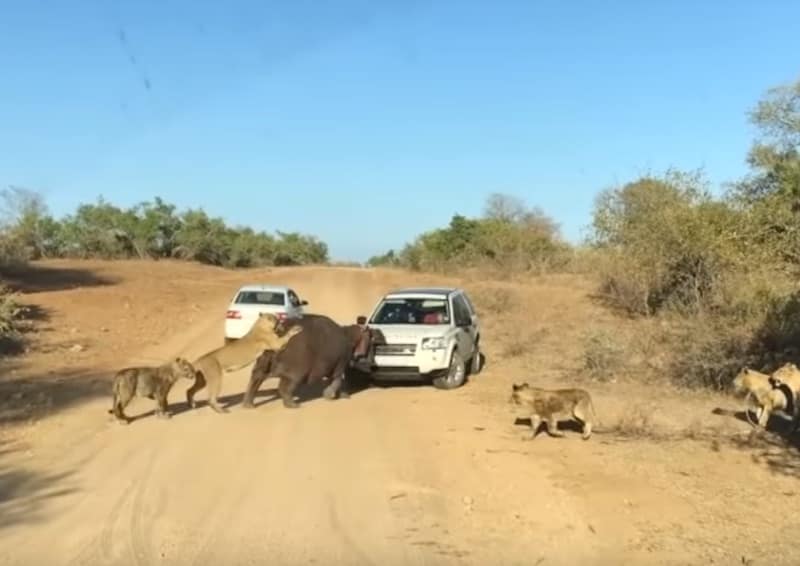
Hippo are semi-aquatic. They usually like to lurk in water, staying cool, sending turrets of water into the air. They can stay underwater for up to five minutes!
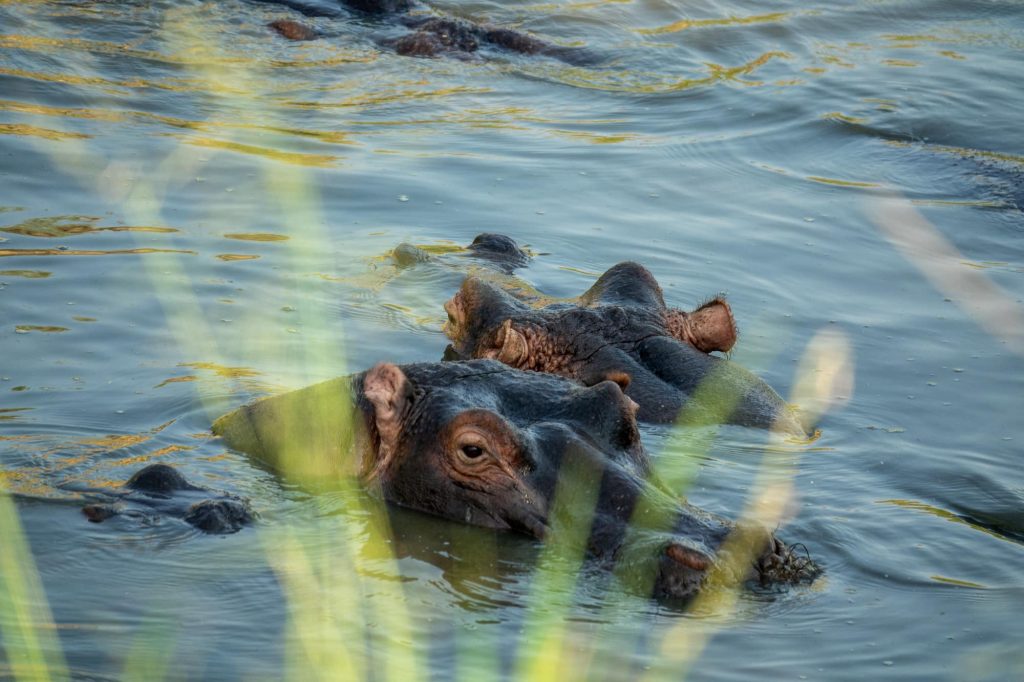
Wrap up
Hope you liked this glorified gallery of safari. I can’t urge enough: go while you can, and contribute to conservation funds where possible. We’ll write more guides on both soon.

